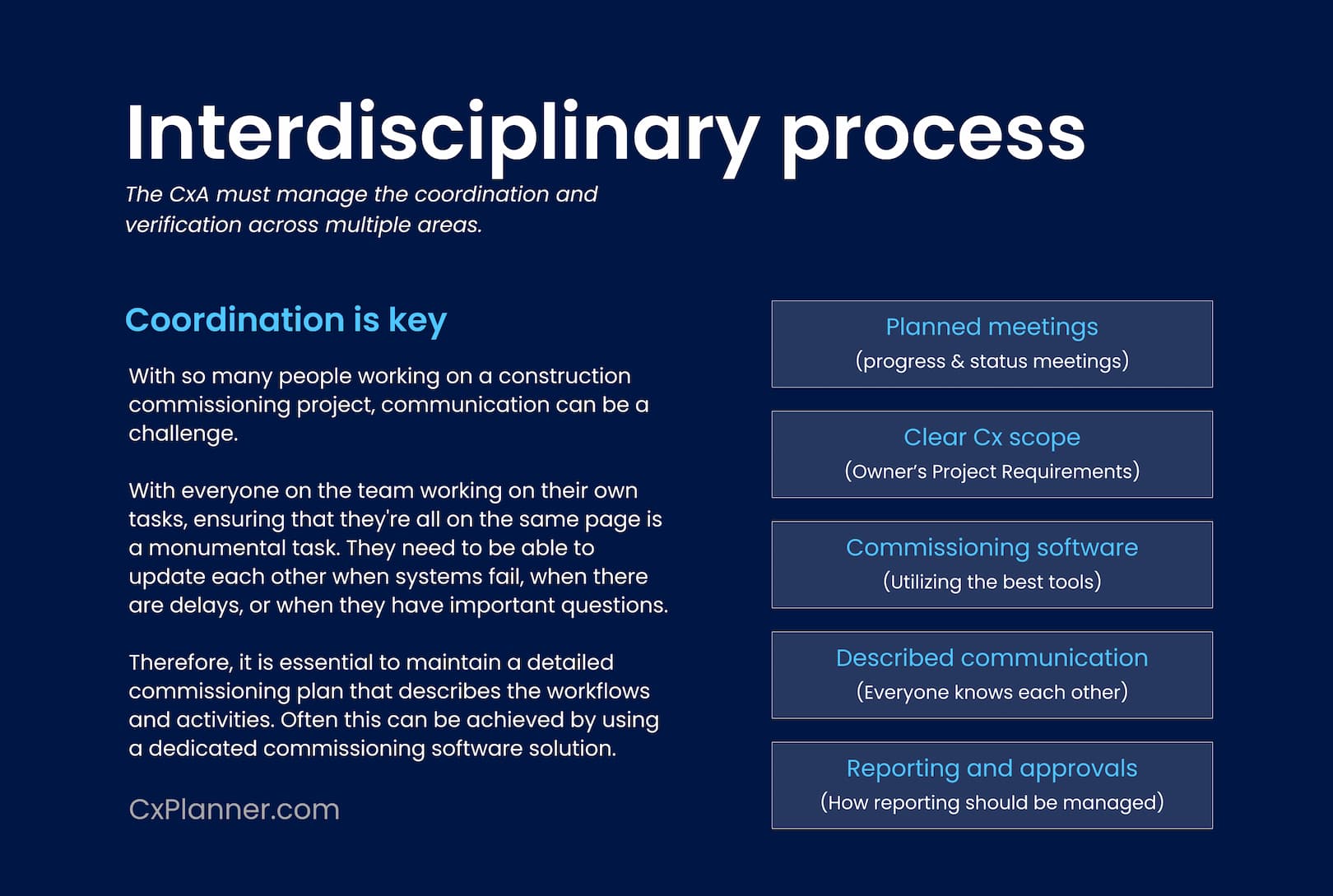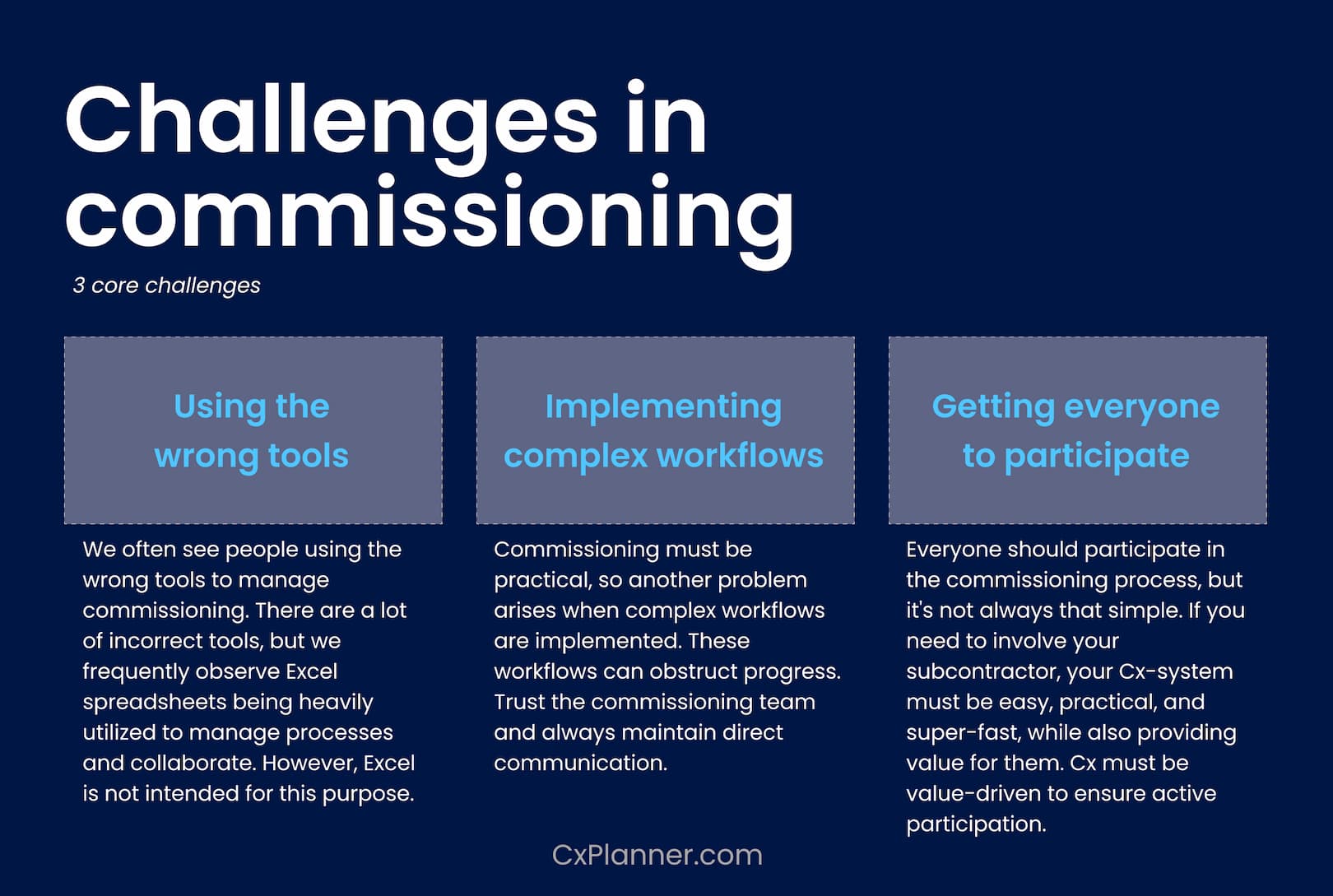Table of content

 What is Commissioning in Construction?
What is Commissioning in Construction?
The process of constructing a building from an idea is quite organic. It starts as a thought, then becomes a design, then a plan, and then a physical structure. Along the way, many things have to remain somewhat fluid to work in the practical world. But that doesn't mean “anything goes.” There must still be real, actionable requirements that the project must meet, and there needs to be a system in place to ensure the project meets those requirements.
That's what commissioning in construction does. It takes a comprehensive, deep dive into the entire construction project and all its systems and ensures that they meet the owner's expectations. Construction commissioning breaks down massive, complex projects into smaller, organized bits. Here's a breakdown of commissioning in construction and what construction commissioning is.
 Phases of Construction Commissioning
Phases of Construction Commissioning
Construction commissioning (Cx) can't happen all at once. It's a process that requires planning, implementation, review, and more. It also happens throughout the life of the project and looks different at each phase. The following are the common phases through which the majority of the commissioning process occurs.
Pre-Construction Checks and Preparations
The pre-construction checks and preparations phase holds the beginning of the commissioning process. Some of the most important facets of the process occur at this phase. They include:
- A construction commissioning agent (CxA) is assigned and the Cx team is developed
- The team establishes the owner's project requirements (OPR) and develops a plan to test the project against these requirements
- The Cx team reviews and inventories all of the different systems that the building will contain and that require commissioning (structural, mechanical, electrical, plumbing, control, safety, elevator, and other systems)
- The team assigns and coordinates the commissioning tasks to make the overall construction commissioning process easier to achieve
The pre-construction checks and preparations phase is really the cornerstone of the commissioning process. Construction commissioning software can make this phase easier to work through, helping the CxA and Cx team quickly and clearly assign necessary tasks in a user-friendly format.
Execution: On-Site Activities and Checks
After the pre-construction checks and preparations process, the Cx team will begin the on-site activities and checks. All of the tasks should be assigned to members of the team, allowing them to move quickly through the construction commissioning process.
This phase can include everything from testing air handler units to verifying that the lighting is working efficiently and set to the correct brightness. The team will verify that these systems work as they should, are as efficient as necessary, and that each of the systems meets the OPR. If not, corrective actions can be taken to fix the issues and ensure that these machines work properly.
Post-Construction Review and Verification
Once all of the on-site activities and checks are complete and the construction project wraps up, the construction Cx process hits the next phase. The team will assemble reports of all the findings they've compiled during the testing phase. They'll then compare those findings to the owner's project requirements to verify all the requirements were met.
If everything is on par, the project reaches “handover.” This is when the commissioning agent signs off on the building and its systems, ensuring everything in the building is working as it was designed to do.
 Role of Commissioning Agents
Role of Commissioning Agents
The commissioning process hinges on a capable commissioning agent. The formation of the Cx team, the commissioning plan, and the execution of the construction commissioning process all depend on this person's knowledge and experience.
Responsibilities and Expertise in Construction Commissioning
Much of the construction commissioning process depends on the commissioning agent. This person is a third-party agent that works for the project owner. They must have no financial ties to the contractor, the building, or any of the systems.
The commissioning agent's role involves:
- Assembling the construction commissioning team with all of the contractors, subcontractors, and maintenance personnel required
- Identifying the scope of the commissioning project, including all of the structural, mechanical, electrical, and other systems that need testing
- Identifying the owner's project requirements
- Creating a plan to test those systems and assign tasks to team members
- Reviewing the construction commission documents to identify issues or find inefficiencies
- Reviewing submittals throughout the construction process to ensure they are compliant with code and OPR
- Preparing the commissioning test for handover
- Ongoing construction commissioning testing
These are complicated tasks that require experience and expertise in the construction field to manage. Assembling an effective plan, reviewing submittals for potential issues, identifying inefficiencies before they pose a problem, and knowing who can handle which aspects of the tests take in-depth knowledge of the construction process.
Construction commissioning software can make the process easier. CxPlanner can organize all of the important documents and reports, as well as create a platform for communication. It also helps the CxA create a clear, easily understandable plan to follow where every task is assigned to simplify the commissioning process.
 Challenges in Construction Commissioning
Challenges in Construction Commissioning
Despite having an expert CxA spearheading the construction commissioning process, there are always challenges to overcome. While each project is different, there are common challenges that construction commissioning teams should be aware of and look out for.

Project Size
Construction commissioning encompasses the building as a whole - and everything in it. As such, these projects are much larger in scale and more complex than commissioning one system or a piece of equipment. The timeline is longer, there are more tasks, more people are involved, and the documentation required far exceeds that of simpler commissioning tasks.
These projects need to be well-organized and planned. This takes an experienced CxA as well as construction commissioning software to clearly define everyone's roles and make the information easy to understand and follow.
Addressing Construction Delays
Delays are so common in the construction industry that they're almost expected. And, since they are so common, they often impact the commissioning plan. Delays can throw off the commissioning schedule, bring it to a halt, or force the team to rethink the plan and go with another route, doubling back later when they can.
So what's the best way to address construction delays during the commissioning process? By using nimble planning and overview software. When commissioning teams can track their team's progress and restructure the plan and schedule accordingly, they're able to absorb construction delays and keep the overall process on track.
Navigating Regulatory and Compliance Issues
While the entire goal of construction commissioning is to satisfy the OPR, the owner isn't the only one with requirements that need to be met. Regulatory bodies are always putting out new regulations and changing requirements, complicating the process of taking a building from pre-planning to handover. An experienced agent will stay up to date on these regulations to ensure the building meets all of the requirements.
Compliance issues can also be a challenge, as the two are closely linked. These issues can be rooted in building safety, materials, design, and more. The Cx team should be on the lookout for these compliance challenges early in the process to avoid their impacts.
Also, when it comes to achieving LEED certification, construction commissioning and compliance with the V4 standards are critical. For example, credits in the Energy and Atmosphere category have prerequisites in Fundamental Commissioning and Enhanced Commissioning, worth up to 6 points toward certification.
Maintaining Effective Communication
With so many people working on a construction commissioning project, communication can be a challenge. With everyone on the team working on their own tasks, ensuring that they're all on the same page is a monumental task. They need to be able to update each other when systems fail, when there are delays, or when they have important questions.
Luckily, there are software platforms that can streamline communication. Construction commissioning software like CxPlanner allows the variety of parties commissioning a project to leave notes, reach out to one another, and store information for others to reference. This ensures everyone is on the same page and knows where the project stands.
 Innovations in Construction Commissioning
Innovations in Construction Commissioning
Construction commissioning is a relatively new process (it only really caught on in the 1980s), but it has come a long way. The following are some of the most impactful innovations that are improving the way things are done within the Cx process.
The Rise of Digital Tools and Commissioning Software
Digital tools are revolutionizing the way Cx is performed. Rather than a pile of documents in a briefcase or a complicated spreadsheet that may or may not be accurate, construction commissioning software puts everything in the palm of the user's hand.
Access to project documents, real time data, and user-friendly tasks that can outline the steps for commissioning are just a few ways this software is changing Cx. Also, the ability to restructure tasks and update everyone to changes and delays ensure that everyone is up to date.
Integration of BIM (Building Information Modeling) in Commissioning
Building Information Modeling, or BIM, has been shaking up the design and planning process in the construction industry in recent years. These programs can effectively simulate not only the look and layout of a building but also how the systems within that building will work over time.
And that's part of what the construction Cx process does, as well.
By using this software during Cx, the team can determine the long-term efficiency and maintenance needs of a system using BIM. CxPlanner takes this even further, allowing users to upload some 3D models into the software and utilize measurement tools, mini-maps, first-person control, and more. They'll be able to use this technology to better develop plans to include every facet of the Cx process, with all of it laid out in front of them in a handy BIM model.